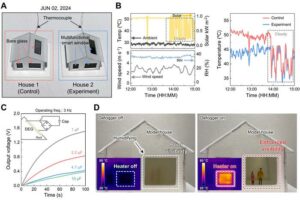Researchers from Seoul National University have announced the creation of a prototype “smart” window that can generate usable electricity from the impact energy of raindrops. The windows also reflect infrared light to reduce indoor temperatures without changing their transparency, which could reduce the cost of keeping buildings cool during warm weather.
They also automatically clear themselves of frost during cold weather. According to the published research outlining the breakthrough windows, this combination of abilities makes their prototype device the first multi-functional Plus Energy smart window ever built.
“In this work, we present an energy-saving multifunctional smart window (MSW) that delivers multi-mode functionalities of radiative cooling, energy harvesting, and defrosting/defogging only with a single device structure for the first time,” they write. “According to the author’s best knowledge, no research has yet been reported on the smart windows that seamlessly integrated multi-modal functionalities in the all-in-one smart device.”
Smart Window Reflects Heat and Automatically Defrosts
In the press release announcing the development of the energy-producing smart window, team leader Professor Seung Hwan Ko from the Department of Mechanical Engineering at Seoul National University and colleagues point out that modern smart windows are limited in their overall functionality.
For example, most only reduce incoming radiative energy by making the window more opaque, “thus failing to maintain high transparency, which is the window’s primary function.” Instead, the team’s new smart window can maintain its full transparency while reflecting a large portion of the infrared heat energy away from the building.
To accomplish this feat, the window is constructed with what the team describes as a layered structure of silver and ITO (Indium Tin Oxide), “materials with excellent electrical conductivity and unique optical properties.” As a result, the visible light passes through the window while the infrared is blocked, reducing heat without reducing visibility. The researchers also point out that, unlike conventional air conditioning systems that use refrigerants, this type of radiative cooling technology “offers cooling performance without consuming electrical energy.”
Secondly, through a process known as “Joule heating,” the layered material functions as self-heating transparent electrodes “that quickly remove frost or ice from the window, ensuring clear visibility on cold days.” Notably, neither of these capabilities requires added energy but instead relies on the material properties of the silver and ITO layers to reflect heat and automatically defrost themselves.


(B) Actual temperature data measured inside the model houses
(C) Energy storage through power generation from raindrops
(D) Ensuring visibility through the transparent heater function. Image Credit: © Science Robotics, originally published in Science Robotics.
How To Generate Power from Raindrops
Perhaps the smart window’s most intriguing capability is its ability to generate usable electricity from the impact force and friction of falling raindrops. Although the team explored other energy harvesting options, like solar or wind power generation, they ultimately determined that the design of their smart windows would best support reliable power generation.
“Water droplets provide rich sources for generating electricity to continuously power the electronics, and the previous literature showed that droplet-based electricity generators (DEGs) can produce sustainable electricity from droplets by liquid-solid contact electrification and electrostatic induction,” they write.
The researchers also highlight a wide range of potential methods for collecting the energy from raindrops and converting it to electricity. However, like the “rain panel” energy generator previously covered by The Debrief, the team zeroed in on a power-generating device called a triboelectric nanogenerator (TENG) that generates electricity in several applications.
The team states that of these diverse energy harvesting methods, “TENGs can offer a practical solution due to their ability to convert natural energy, such as vibration, wind, flowing water, and ocean waves, into electricity for sustainable power generation.”
The research team says that the most efficient type of TENG would include a dielectric material that exhibits “outstanding” triboelectricity and is “highly transparent in the visible light spectrum to operate as a conventional window.” As noted, the silver and ITO layered material design they had already selected contained both properties.
After building their prototype, the team found that the triboelectric energy generation ability of their smart window was even more efficient than they had expected. According to the press release, “In an experiment simulating rainy conditions, the smart windows generated 8.3 W m-2 of power with just a single raindrop.”
By combining the power generation from raindrops with the radiative cooling of infrared heat energy, the research team says the smart windows they developed maintained a temperature “approximately 7 degrees lower than regular windows in hot environments under direct sunlight.” The windows also cleared frost from the window “twice as fast as regular windows” through Joule heating. Together, these capabilities demonstrated “both high performance and multifunctionality.”
Pursuing Plus Energy Buildings
According to Professor Ko’s team, the ultimate goal of developing their smart window was to move past the goal of creating Zero Energy Buildings (ZEBs) and help usher in the era of Plus Energy Buildings (PEBs). In the press release, they explain that PEBs “are buildings that go beyond minimizing energy loads and can autonomously produce energy.”
“It is necessary to develop multifunctional smart windows equipped with transparent cooling technology (Zero Energy-based) and further energy-harvesting technology (Plus Energy-based) that ensures sustainable power supply,” they explain.
The team says their prototype smart window accomplishes this goal by combining three energy-supporting capabilities. First, it provides radiative cooling that lowers indoor temperature on sunny days without energy input. Second, it can generate electricity using the energy from raindrops, and third, “it implements a transparent heater function to quickly remove frost from the windows on cold days.”
Although they are not yet commercially available, the study’s lead author, Dr. Yeongju Jung, is conducting follow-up research to improve their design with the ultimate goal of a commercially viable window. According to Professor Ko, providing consumers with this type of triple-function smart window is more critical than ever, given the efforts to move beyond fossil fuels and improve overall energy efficiency.
“Presenting next-generation smart window technology optimized for responding to the depletion of fossil fuels and global warming offers valuable insights into the technological advancements for Plus Energy buildings and the eco-friendly electric vehicle industry,” he said. “Smart windows are expected to be applied across various industries because they address environmental pollution, reduce cooling energy, and overcome the limitations of conventional battery technologies through self-power generation.”
The study “Energy-saving window for versatile multimode of radiative cooling, energy harvesting, and defrosting functionalities” was initially published in the journal Nano Energy.
Christopher Plain is a Science Fiction and Fantasy novelist and Head Science Writer at The Debrief. Follow and connect with him on X, learn about his books at plainfiction.com, or email him directly at christopher@thedebrief.org.

